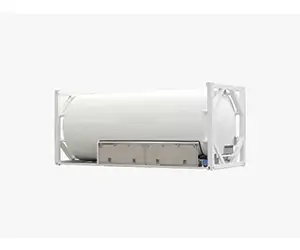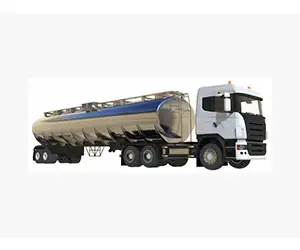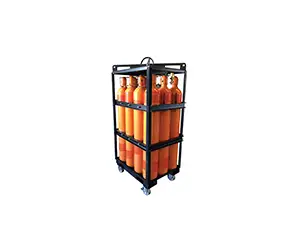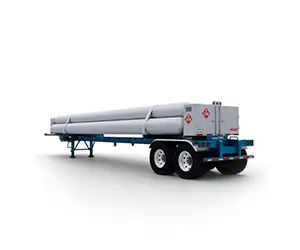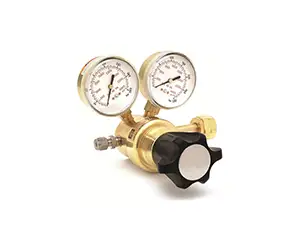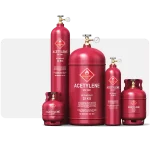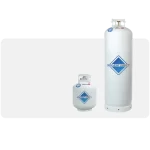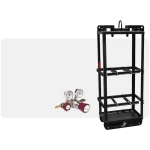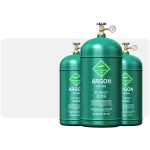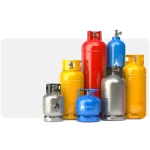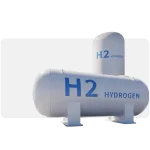Inspection and periodic tests of gas cylinders
Periodic testing of gas cylinders according to valid TPED, UKAS and DOT standards.
All compressed gas cylinders must be hydrostatically tested every 10 years to ensure they are safe and fit. Gielle has in-house testing facilities to enable us to perform cylinder testing. We hydrostatically test and maintain fire extinguisher cylinders, lifeboat cylinders and BA cylinders to TPED, UKAS and US DOT standards. Hydrostatic testing involves filling a cylinder with water and placing it inside a pressurized chamber filled with water. The water pressure inside the cylinder increases (150% of the maximum working pressure) and causes the cylinder to expand slightly.
This in turn displaces a small amount of water from the chamber, which is collected and measured. If the cylinder expansion is within the set limits (< 5%), the cylinder has passed and can be certified for purpose. Matching cylinders are dried, sealed with the current month and year, refilled with the appropriate suppressant, and returned to service. Damaged cylinders must be discarded.

Our in-house inspection organization is accredited by TPED, UKAS and DOT, ensuring that all cylinders are tested impartially and to the highest possible standards. Our fully trained inspectors carry out periodic fire extinguisher cylinder tests for facility management and fire extinguishing engineers around the world. Our state-of-the-art equipment is routinely calibrated and verified by independent inspection bodies to ensure our in-house testing is accurate and effective.
Hydrostatic test frequently asked questions
Valid TPED and DOT standards require that all cylinders be hydrostatically tested every 3, 5 or 10 years. The time allowed by law is determined by various factors such as the type of material, the gas contained in it, its age and the special licenses under which the cylinder may have been manufactured.
What is a hydrostatic test?
“Hydro testing” is an approved method of testing the structural integrity of a compressed gas container. It is done by removing the tap, filling the container with water and then pressing the container above its working limit. Cylinder expansion is measured, recorded and analyzed. If the cylinder expands beyond a certain limit, the cylinder must be condemned.
How often is a hydraulic test necessary?
It depends on the cylinder rating and the date of its last test. The month and year of each hydraulic test between one letter and four numbers identifying the tester is stamped on the cylinder.
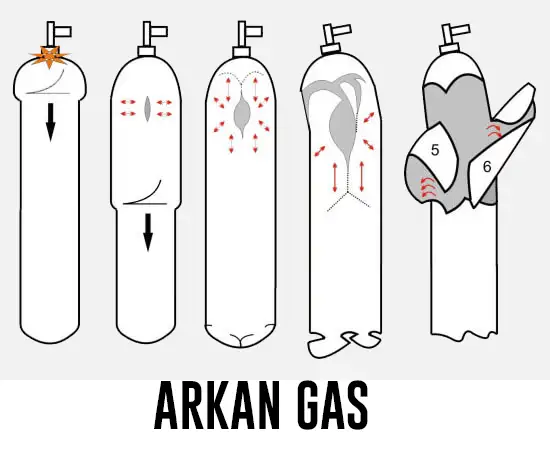
Hydrostatic test and tank inspection
Hydrostatic testing is the most common method for inspecting a compressed gas container for leaks or defects. The cylinder is subjected to a hydrostatic test to determine whether it can safely maintain its rated pressure. Hydrostatic testing is very important when it comes to compressed gas containers because they can explode if they fail while containing compressed gas.
Hydrostatic testing involves filling a container with a virtually incompressible liquid (water) and checking it for leaks or deformation. The test pressure is significantly higher than the operating pressure to ensure safety. Usually 150% working pressure is applied. Water is used in hydrostatic testing because it is nearly incompressible and expands only very slightly.
If high pressure gas is used, it can exceed its compressed volume and pose a risk of explosion. All compressed gas containers require regular hydrostatic testing. The maintenance frequency depends on the cylinder material.
DOT recommends regular visual inspections as well. DOT requires that hydrostatic retesting and requalification be performed by registered, certified professionals. Gielle has all the necessary qualifications for hydrostatic testing, so you can trust our company to check your compressed gas cylinders.
The purpose of pressure tank testing is to check if there is a significant pressure drop, which is usually a sign of a crack or hole in the tank. Pressure buildup is a potentially dangerous situation, which is why this type of test should be performed by a plumbing professional.
Gielle specializes in hydrostatic testing and cylinder maintenance. Our customers include the military, major gas manufacturers, independent welding supply companies, fire suppression companies, fire departments and municipalities.
Periodic testing of cylinders under pressure under the supervision of EIE and SGS inspection company is approved by Iran Institute of Standards and Industrial Research.
Periodic test of cylinders under pressure through hydrotest using Water jacket and Non water jacket volumetric expansion test methods
Cylinder hydrotest
Hydrostatic testing is one of the ways to test pressure and leakage for pipelines, piping, gas cylinders, boilers and fuel tanks. The test includes filling the tank with a liquid, usually water. The cylinder test and pressure test are also performed. At this stage, the gas tank may change shape. The gas cylinder test is the most common work method for test pipes and pressure tanks. With this test, the safety and durability of the tanks are checked according to the standards for a certain period of time. The hydrotest of the capsule must be done at regular intervals, in order to avoid accidents and unfortunate events such as Leakage or explosion can be prevented. The hydrostatic test of gas tanks is done according to the industry and customer requirements based on the standard. For this purpose, water or oil is used, and in some cases, red or fluorescent color is also used for better visibility. All cylinders under normal conditions, due to the erosion and corrosion that occurs inside the cylinder, five years after the date of production and after They need periodic cylinder test every year.
 Persian
Persian Englisg
Englisg Arabic
Arabic
